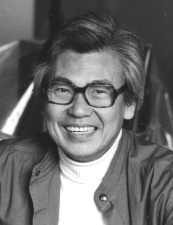Wen-Ying Tsai
American artist (1928–2013)
(Redirected from Tsai Wen-Ying)
Wen-Ying Tsai (October 13, 1928 – January 2, 2013) was an American pioneer cybernetic sculptor and kinetic artist best known for creating sculptures using electric motors, stainless steel rods, stroboscopic light, and audio feedback control.

| This article about an artist is a stub. You can help out with Wikiquote by expanding it! |
Quotes about Wen-Ying Tsai
edit- There can be no doubt that Tsai's phenomena (whether they be works of art in the strict sense, or whether they be fantastic artifices) are extremely important. They show what promises and dangers may be in here in a "play," if it is proposed by a great artist. Because, even if Tsai's phenomena be considered artifices, there can be no doubt that Tsai is a great artist. Not because what he does is pleasant, or because he proposes a play, or because he represents the spirit of our times, but because he reveals to us, through artifice or works of art, the concrete experience of a future full of promise or abysmal danger.
- Vilem Flusser, Aspects and Prospects of Tsai's Work, Art International, March 1974
- As far as the sensory experience of the spectator goes, the most outstanding American kinetic artist is unquestionably the Chinese-born Wen-Ying Tsai. His pieces, which are perfect on the technological level, serve the primary purpose of giving a complete visual experience to the spectator, whose sound solicitations provoke a choreographic, chromatic and rhythmic response in the ‘cybernetic sculptures’. [...]
- György Kepes has commented enthusiastically on the ‘magic rhythms emanating from this swaying, dancing steel trembling with life’, and he has also noted the sense of ‘an instant fellowship, a spontaneous celebration’ which is re-created in their presence. As he concludes: ‘Rhythm is friendship and in Tsai’s work there is friendship of light, sound and our own heart-beats.’
- If this appraisal testifies to the success with which Tsai affects the sensory and emotional responses of the spectator, we must not neglect the fact that he is also addressing himself to reason and the scientific element in his audience. In effect, the observer can enter an almost mathematical relationship with these works, and sharpen his perceptual powers through the exact assessment of the various aesthetic parameters of vibration, sound, colour, wave movement, etc.
- Frank Popper, Art--Action and Participation, New York University Press, 1975, p. 214
- Tsai's Multi-kinetics were dynamically integrated multiple constructions, employing thirty-two kinetic units, each of which contains a configuration of multi-colored gyroscopic forms. With these elements he created an active environmental field that could, apparently, be infinitely extended. Each motorized unit was a self-sufficient entity, and when it was combined with other similar units produced a large-scale kinetic work that joined visual intensity with mechanical power. By controlling the time sequence of each unit in skillful compositions, Tsai used engineering principles to achieve aesthetic ends.
- Sam Hunter, The Cybernetic Sculpture of Tsai Wen-Ying, exhibition catalogue, National Museum of History, Taipei, 1989, p. 66-67